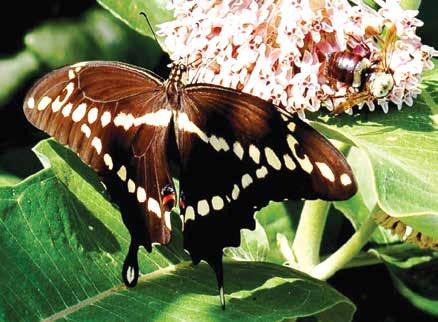
3 minute read
Kids Ask Dr. Bug
about the curious things found in the garden
Where do leaves come from? Dalton, 14
Every spring I eagerly wait for the leaves and flowers to burst out of what seems like dead wood. As it starts to warm up, the buds on the tree branches begin to swell. Soon leaves, and perhaps flowers, emerge depending on the tree species. This emergence process starts the previous year as the tree gathers and stores energy in the roots, and special cells form buds on branch twigs. These special cells grow in what is called the meristem. These cells can become the leaves and flowers in the spring. As temperatures rise and the days get longer, sugar starts moving upward from the roots, and the buds begin to swell. The special cells start to grow and divide and eventually burst out of their protective winter covering as leaves and/or flowers. As the leaves unfurl, they become food-making machines. The green color of leaves is from chlorophyll which harvests energy from sunlight to turn water and carbon dioxide into sugar and oxygen by a process called photosynthesis. This sugar is then used to help the plant grow. Some of the sugar is eventually stored back in the roots for next year’s leaves.
Why are there so many flowers in the spring? Aubrey, 13
Plants produce seeds to grow new plants. Before seeds are created, though, flowers must have bloomed to attract the pollinators, pollinators must come and share pollen from other plants of the same species, and then seeds develop. To create seeds with a better chance of survival, some plant species go to the extra effort of creating a tasty treat that surrounds the seeds so that animals will eat the seeds and take them further away. Alternatively, sometimes the surrounding fleshy part acts as a nutrient for the new seed to grow in the ground near the parent plant. All this effort takes time, and for some plants it takes months. So, the process starts in the spring when hungry insect pollinators are looking for food to feed themselves and to start collecting food for their offspring.
I don’t know if insects feel fear, but I know that many of them react when they sense they are in danger. I tried to take a picture of a ladybug this weekend. She didn’t know I was only observing her and so she engaged a protective strategy – staying still. While she is brightly colored and I could obviously see her, staying very still, or playing dead, is actually a very effective strategy that many insects use to avoid being eaten. Some insects even go to great lengths to play dead – falling off the plant and freezing, sometimes for a few seconds, a few minutes, or even an hour. While staying still may seem counter-productive when a predator wants to eat you, staying still has a few advantages. Some predators only notice movement while everything else is just background. Some predators only hunt living prey. And, if the insect falls when it freezes, it puts more distance between itself and the predator.
Ladybugs also have another defensive strategy: they can squirt a foul-smelling liquid from their “knees”. This can warn potential predators that they taste bad and are not worth eating. Here are some other defensive strategies in the insect world: some ants explode, bombardier beetles spray boiling hot chemicals toward the predator, stink bugs give off a foul odor like a skunk, walking sticks freeze or gently sway back and forth pretending to be a twig in a breeze, and some insects bite or sting.
As for the ladybug I was observing, it initially seemed helpful that she stayed so still while I tried to get a close-up picture of her. However, I wanted to capture her hunting the nearby clover mites. She was more patient than me! I left without the picture I hoped to get.
Photo credit to Tamra Reall.
Above: Magnolia flower; Below: Ladybug

Do insects get scared? Oliver, 14 Do you have a question for Dr. Bug? Send them to ReallT@Missouri.edu. Please include KADB in the subject, and your name and age. To help me learn what you learn from this column, please consider filling out this survey: bit.ly/KidsAskDrBugSurvey. Thank you!
TAMRA REALL Horticulture Specialist
Dr. Tamra Reall (@MUExtBugN Garden) is the horticulture specialist for MU Extension in Jackson County. For free, research-based gardening tips, call 816-833-TREE (8733), email mggkc.hotline@gmail.com, or visit www.extension2.missouri.edu.










